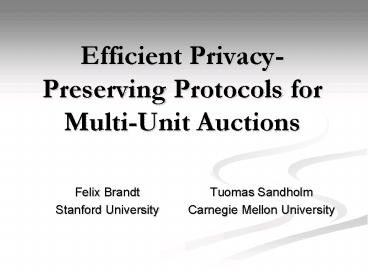Efficient PrivacyPreserving Protocols for MultiUnit Auctions - PowerPoint PPT Presentation
1 / 16
Title:
Efficient PrivacyPreserving Protocols for MultiUnit Auctions
Description:
Felix Brandt. Stanford University. 9/5/09. 2. FC 2005. Overview. Auctions (sealed-bid, multi-unit) ... Naor et al 99, Abe et al 02, Lipmaa et al 02, Brandt 03, etc. ... – PowerPoint PPT presentation
Number of Views:31
Avg rating:3.0/5.0
Title: Efficient PrivacyPreserving Protocols for MultiUnit Auctions
1
Efficient Privacy-Preserving Protocols for
Multi-Unit Auctions
- Tuomas Sandholm
- Carnegie Mellon University
Felix Brandt Stanford University
2
Overview
- Auctions (sealed-bid, multi-unit)
- Privacy, correctness related work
- Bidder-resolved auctions
- Order statistic subprotocol
- Secure multi-unit auction protocols
- Analysis
- Conclusion
3
Sealed-Bid Auctions
- Each bidder submits sealed bid to auctioneer
- Auctioneer opens all bids and declares outcome
(i.e., allocation and prices) - English auction 2nd-price sealed-bid
(Vickrey)Independent private values - Dutch auction 1st-price sealed-bid
- Advantages Efficiency and privacy
4
Multi-Unit Auctions
- M indistinguishable units of one item
- Each bidder submits bid vector
where denotes the price bidder i is willing to
pay for jth unit (bidder is willing to pay
for m units) - Auctioneer computes allocation that maximizes
revenue (NP-complete) - Marginal decreasing valuations? tractable
- Classic applications Treasury bills, electrical
power, spectrum licenses - CS applications CPU time, network bandwidth
5
Common Pricing Schemes
- Uniform-priceAll bidders pay same unit price
given by (M1)st-highest bid - DiscriminatoryBidders pay what they bid (
for mi units) - Generalized VickreyBidder who receives mi units
pays sum of mi highest losing bids submitted by
other bidders
6
Privacy and Correctness
- Bidders are reluctant to reveal their bids to
auctioneer - Confidentiality of private information
- Significance for current auction and future
negotiations - In (generalized) Vickrey auctions bids are
usually equal to valuations due to dominant
strategy equilibrium - Bidders doubt the correctness of the outcome
- Especially in Vickrey auctions
7
Related Work
- Cryptographic single-unit auction protocolsNaor
et al 99, Abe et al 02, Lipmaa et al 02, Brandt
03, etc. - 1st-, 2nd-, and (M1)st-price (unit demand)
- Multiple auctioneers (either two (asymmetric MPC)
or more (threshold MPC) - Cryptographic combinatorial auction
protocolsSuzuki et al 02 and 03 - Exponential worst-case complexity
8
Auctions without Auctioneers
- Bidders jointly emulate virtual auctioneer,
i.e., they jointly compute outcome function
without revealing any information in addition to
outcome
Auctioneer
Bidder 1
Bidder 2
Bidder 3
Bidder 1
Bidder 2
Bidder 3
9
Multiparty Computation (MPC)
- General MPC is (still) inefficient
- Special-purpose MPC auction protocols based on
- Linear combinations
- Random multiplications
- Efficient implementation using homomorphic
encryption (El Gamal) and standard ZK-proofs - Low round complexity
- Communication complexity linear in number of
prices
10
Vector Representation
- Bids are expressed in unary notation
- Linear combinations (multiplication with
matrices) - Random multiplication matrix R
11
Order Statistic Subprotocol
- Example
- Extra work required due to possibility of ties
involving mth-highest bid (total of m(N-m)
vectors)
12
Compute Allocation
- Additional vectors to enable tie-breaking
13
Compute Prices
- Uniform-price auction
- Discriminatory auction
- Generalized Vickrey auction
14
Protocol Implementation
- Round 1 Distributed generation of El Gamal keys
- Round 2 Publishing El Gamal encryptions of bids
- Round 3 Joint computation of outcome vectors
- Round 4 Distributed decryption of outcome
- One additional round for discriminatory auction
- Two additional rounds for generalized Vickrey
auction
15
Analysis
n bidders, M units, k prices
16
Conclusion
- Fully private bidder-resolved constant-round
protocols for all three common types of
multi-unit auctions - Feasible for moderately-sized settings (tens of
bidders, hundreds of prices) - Linearity in number of prices
- High communication complexity
- Straightforward adaptability to iterative
auctions






























